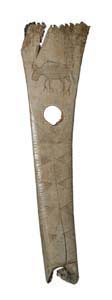
 |
| Engraved arrow-shaft wrench made of a bison rib. From the Guebert site, a Kaskaskia Illinois village (1719-1765). view details |
They make . . . Their Ladles out of the heads of cattle, whose Skulls they know so well how to prepare that they use these ladles with ease for eating their sagamité [boiled corn meal]. (Jacques Marquette, 1674)![]()
Bones obtained from animals like deer, elk, and bison were modified to create a variety of tools: beamers for scraping animal hides, awls for sewing, needles for making reed mats, and wrenches for straightening arrow shafts. The shoulder blades of bison were perforated and attached to long handles to create hoes, which were used not just to weed gardens but also to dig holes in the ground. Bison horn was cut and polished to make scoop-shaped ladles used for eating food. Deer antlers were cut and scraped to create cone-shaped projectile points that were attached to the ends of long wooden spears. Unmodified antler tines were also used as flaking tools to make chipped-stone artifacts. ![]()
 |
| Line drawing of bison-scapula hoe, composed of the shoulder blade of a bison lashed to a wood handle. (drawing by Frederick Wilson) |
 |
| Hoe blade made from the scapula (shoulder blade) of a bison. From the Zimmerman site, a Kaskaskia Illinois village (1673-1722). |
|
|
Copyright © 2000 Illinois State Museum